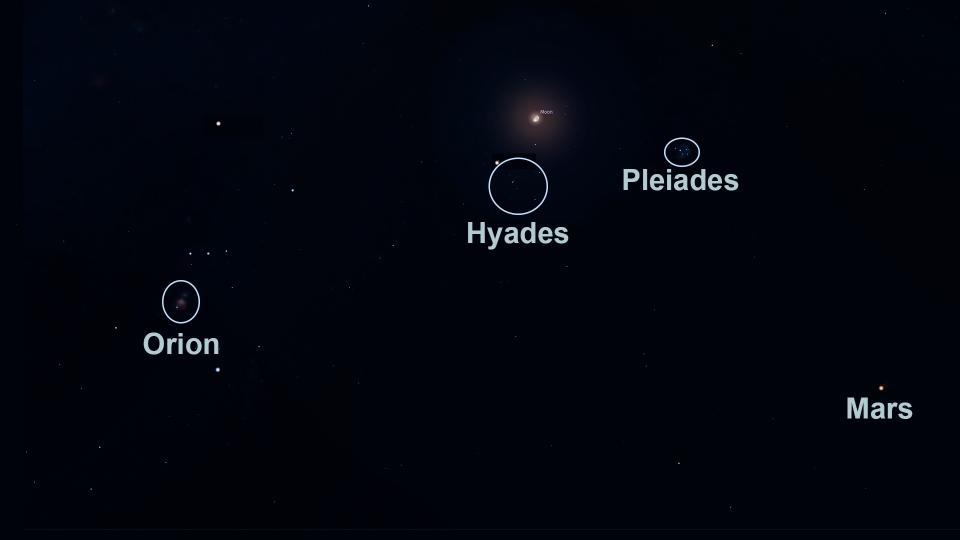
One of my favorite things to show people this time of year is the trio of the Orion nebula, the Pleiades, and the Hyades cluster. These systems are each snapshots in the evolution of open star clusters. While each of these systems is home to young stars, they are at very different developmental stages. Right now, the Moon is near these clusters and can help you find them, although it will also drown out some of their light.
The Orion nebula is very much a stellar nursery, with stars just ten million years old or younger. It can be found in Orion’s sword and will be visible to the unaided eye in moderately dark areas. This cluster is so young that stars are still forming, and gas still glows around the tight cluster of stars. The Orion nebula is an easy target for cameras with a good zoom lens and a tripod, and the image we’re showing is a backyard photo by Bryan Goff.
If you want to see the next star cluster in our journey. draw a line from the bottom to the top of Orion’s belt and curve that line past the bright burnt orange Aldebaran, until you reach a tiny dipper of stars. This is not the little dipper; this is the Pleiades.

If the Orion nebula is a nursery, the Pleiades is more like a daycare center with stars 100 million years old or younger. There is very little gas and dust left in this system and star formation has come to an end, but the stars are still gathered in a distinct cluster on the sky. For those of us here in the northern hemisphere, this is the easiest to see a fuzzy object in the sky, in my personal opinion.
Our final cluster is the hardest to see because like teenagers with their drivers’ license, these stars have started to scatter to the wind. To find the Hyades, go back to burnt orange Aldebaran and notice how there are more stars in that region of the sky than in the surroundings. These are the stars you’re looking for!
Many of these stars have been shown to be moving together. The Hyades cluster is home to stars 730 million years old or younger and is basically dust- and gas-free. The reason this system appears so sprawled out is a problem of orbital mechanics. As this cluster goes around and around the Milky Way, stars on orbits closer to the center are moving faster, while those farther out are moving slower. This is stretching the system such that someday in the future, it will be nearly impossible to sort which stars were born together.
Our own Sun was born in a system that may have been like these clusters, and now we struggle to find our siblings. As alone as we are now, it’s kind of cool to know our Sun once grew up in a sparkling cluster with siblings of all sizes.
While you’re looking South at these clusters, also take a look at Mars. Here’s a neat thing to think about: while you can’t see them with your eyes or even with the best telescopes on Earth, that region of the sky contains a small fleet of spaceships, several of which will be landing in February. It’s time to start getting excited, folks. Al Amal, Percy, and Tianwen, we literally have our eyes on you. We just can’t actually see you.




 Join the Crew!
Join the Crew!
 Escape Velocity Space News
Escape Velocity Space News
0 Comments